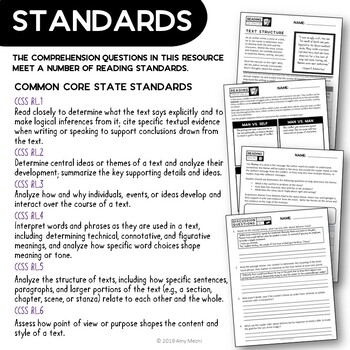Artemis Fowl by Eoin Colfer Complete Novel Study Grades 5, 6, 7
- PDF
What educators are saying
Description
This is a literature guide to Artemis Fowl by Eoin Colfer. This novel unit would be great for use in a literature circle or novel study group. Activities contain higher level thinking reading comprehension questions, vocabulary, as well as extension activities. A complete answer key is included in page format, so pages with answers could be printed for students with IEPs.
To see a complete list of activities, please open the preview.
Summary of Artemis Fowl
Artemis Fowl is a terrific science fiction/fantasy novel for grades 5, 6, and 7. This is book one in a series of stories about Artemis Fowl and his dealings with the fairies. Artemis is a 12 year old prodigy who is determined to reinstated his criminal business family's fortune by stealing the fairies' gold. His bodyguard Butler helps him kidnapped Captain Holly Short, LEPrecon officer. When the fairies send their elite team to rescue her, Artemis begins to question his morality.
Artemis Fowl is an excellent book to discuss themes such as good vs. evil and how characters change and develop throughout a novel. Artemis thinks he is an evil genius, but finds that he may not have the stomach to be evil after all. On the other hand, the fairies accuse the humans of being vicious while also supporting some morally questionable activities.
The target age group for this book is grades 5 - 7.
Novel Unit Contents
The activities are written so that they could be used as individual activities or as a packet that could be given to an independent reading group. The activities are a mix of close reading questions, as well as reading and and writing activities, such as a text structure and rewriting a scene in first person point of view. Vocabulary lists, activities, and quizzes for each reading section are also included.
- 70 student pages
- Complete answer key
- Reading comprehension questions
- Vocabulary lists, activities, & quizzes
- Vocabulary flash cards
- 3 choices of final projects
- book vs movie activity
Targeted Skill Lessons
- Characterization
- Plot Diagram
- Context Clues
- Point of View
- Types of Conflict
- Text Structure in Literature
- Theme
- Character Comparison
- Dynamic & Static Characters
Organizing The Novel Study
This guide is broken down into seven sections of roughly the same length plus after the book activities. There are 70 pages of student activities, so teachers can either use them all or just select the ones that meet their students' needs.
Each section is labelled "Day 1", "Day 2", etc.. However, the teacher could provide more than one class period for each day's activities to be completed.
If using this book as an independent work packet, copy the activities for each student and place the copies in a binder/pronged folder. As Artemis is a "criminal mastermind," the activity pages could be organized in a folder like a CIA case file.
During class, students can take the binder and easily see what they need to complete, as a checklist is provided for each day. Students could be required to turn in certain activities, or the teacher could grade the activities in the binder.
Some activities could be used as partner work or assign to specific students. For example, character development tracking pages are included for the seven major characters. Students could be assigned a character to track and become the "character expert." The students could then add their evidence to class posters and explain the evidence to the rest of the class.





